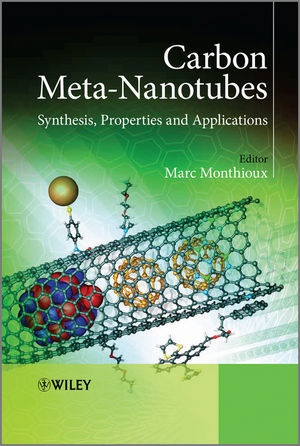Ulteriori informazioni
Informationen zum Autor Dr. Marc Monthioux is Research Director at the French National Research Institute (CNRS), and is currently working at CEMES (Centre d'Elaboration des Matériaux et d'Etudes Structurales, Toulouse, France). He has been conducting research on carbon-related materials since 1979, including coals, cokes, carbon fibers, composites and even oils and derivatives, from the point of view of structure, texture, nanotexture, and behavior (thermal, mechanical, chemical). He has focused his work on carbon nanotubes and related materials since 1998, when he co-discovered "nanopeapods". He has authored more than 130 articles and chapters in refereed journals and conference proceedings, including contributions to ten books, and is co-inventor of two patents. He is currently one of the Editors of Carbon journal and consultant for companies involved in the carbon business. Klappentext Meta-Nanotubes are a new generation of carbon nanotubes (CNTs) which result from the chemical transformation of regular CNTs and their subsequent combination with foreign materials (atoms, molecules, chemical groups, nanocrystals) by various ways such as functionalisation, doping, filling, and substitution. These new nanomaterials exhibit enhanced or new properties, such as reactivity, solubility, and magnetism, which pristine CNTs do not possess. Their many applications include electronic and optoelectronic devices, chemical and biosensors, solar cells, drug delivery, and reinforced glasses and ceramics.Carbon Meta-Nanotubes: Synthesis, Properties and Applications discusses these third generation carbon nanotubes and the unique characteristics they possess. Beginning with a general overview of the subject, this book covers the five main categories of meta-nanotubes, namely:* Doped Carbon Nanotubes* Functionalised Carbon Nanotubes* Decorated or Coated Carbon Nanotubes* Filled Carbon Nanotubes* Heterogeneous NanotubesProviding unparalleled coverage of these third generation or meta-nanotubes, and possibilities for future development, this book is essential for anyone working on carbon nanotubes. Zusammenfassung Meta-Nanotubes are a new generation of carbon nanotubes (CNTs) which result from the chemical transformation of regular CNTs and their subsequent combination with foreign materials (atoms, molecules, chemical groups, nanocrystals) by various ways such as functionalisation, doping, filling, and substitution. Inhaltsverzeichnis List of Contributors xiii Foreword xv List of Abbreviations xvii Acknowledgements xxi Introduction to the Meta-Nanotube Book 1 Marc Monthioux 1 Time for a Third-Generation of Carbon Nanotubes 1 2 Introducing Meta-Nanotubes 2 2.1 Doped Nanotubes (X:CNTs) 3 2.2 Functionalized Nanotubes (X-CNTs) 3 2.3 Decorated (Coated) Nanotubes (X /CNTs) 3 2.4 Filled Nanotubes (X@CNTs) 3 2.5 Heterogeneous Nanotubes (X*CNTs) 4 3 Introducing the Meta-Nanotube Book 4 References 5 1 Introduction to Carbon Nanotubes 7 Marc Monthioux 1.1 Introduction 7 1.2 One Word about Synthesizing Carbon Nanotubes 7 1.3 SWCNTs: The Perfect Structure 11 1.4 MWCNTs: The Amazing (Nano)Textural Variety 18 1.5 Electronic Structure 29 1.6 Some Properties of Carbon Nanotubes 31 1.7 Conclusion 36 References 36 2 Doped Carbon Nanotubes: (X:CNTs) 41 Alain P?icaud, Pierre Petit and John E. Fischer 2.1 Introduction 41 2.1.1 Scope of this Chapter 41 2.1.2 A Few Definitions 42 2.1.3 Doped/Intercalated Carbon Allotropes - a Brief History 43 2.1.4 What Happens upon Doping SWCNTs? 48 2.2 n-Doping of Nanotubes 52 2.2.1 Synthetic Routes for Preparing Doped SWCNTs 52 2.2.2 Crystalline Stru...

